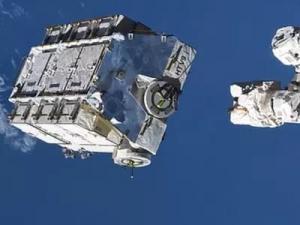Nine batteries that were released from the International Space Station on January 11, 2021, are expected to reenter Earth's atmosphere on Friday, according to statements from the European Space Agency (ESA). Weighing a total of 2.6 metric tonnes, these batteries will undergo a natural reentry process, during which they are anticipated to deteriorate and burn up.
The ESA has assured that the risk of these batteries causing harm upon reentry is very low. "Most of it may burn up during the reentry. While some parts may reach the ground, the casualty risk – the likelihood of a person being hit – is very low," the ESA stated.

The Space Debris and Independent Safety Offices of the European Space Agency are actively monitoring the reentry process, closely calculating estimates for the time and location of the event. According to ESA, the reentry is expected to take place between -51.6 degrees South and 51.6 degrees North. However, due to fluctuating levels of atmospheric drag, precise predictions are currently hindered by large uncertainties. However, Germany is monitoring for debris expected to descend from the International Space Station (ISS) on Friday amid concerns that fragments could potentially land in the western state of Rhineland-Palatinate or other areas of the country.
The German Economic Affairs and Climate Ministry (BMWK) stated that the "object is under close surveillance," with crisis measures prepared in case the debris lands in Germany. The German Federal Office of Civil Protection and Disaster Assistance previously issued alerts via warning apps on Thursday, indicating a low risk of debris landing in Germany. Users were informed that they would receive updated information through the app if the situation were to change.
As these batteries enter Earth's atmosphere, they will encounter air resistance and friction, resulting in intense heating and the formation of a glowing trail, similar to a meteor or shooting star. Some debris may break apart or fragment during entry due to thermal stress and mechanical forces, potentially leading to multiple visible glowing pieces in the sky.
ESA emphasized that large space objects reenter Earth's atmosphere in a natural manner approximately once per week, with the majority of associated fragments burning up before reaching the ground. Most spacecraft, launch vehicles, and operational hardware are designed to minimize risks associated with reentry.
The ESA continues to provide updates on this reentry event as more information becomes available.









